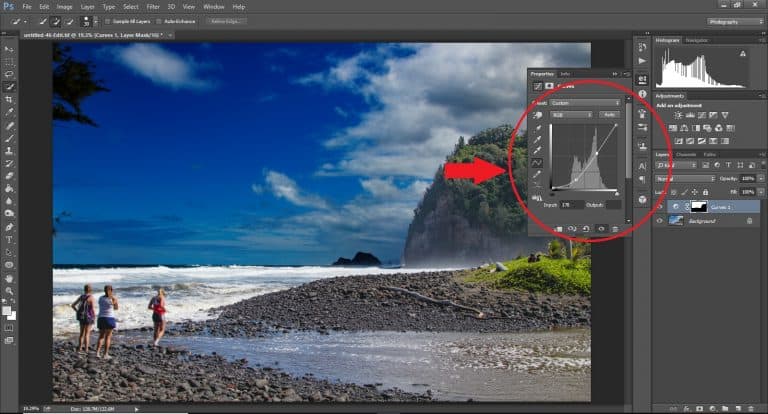Does the thought of learning Photoshop overwhelm you? Start here with The First 5 Things to Learn in Photoshop to Touch up Your Images!
The Adobe Photoshop application is a beast of a thing. There are brushes, layers, masks, filters and about 13,252 different things you can do to your images with it. It can feel really intimidating at first because there are just so many buttons and options. Where should you even start trying to learn it? What are the first things to learn in photoshop to improve your images as a photographer?
We’re here to help. Today, we’ll talk about five skills photographers can learn in Photoshop to touch up or fix their final edits. I’ll cover what those five skills are, how they are helpful to your editing and how to use them. I’ll also link to some more comprehensive tutorials and video tutorials so you can learn it in more than one way!
We will start with two basic skills, creating a duplicate layer and undoing a change and then start with basic skills you’ll want for editing photos. Once you’ve mastered those five skills, you’re ready to move on to another set of skills in this powerful editing program. But first, baby steps!

In-camera vs. Post Production
As photographers, our goal should always be to get our image as close to perfect in camera as possible. But let’s be honest…sometimes that doesn’t happen. Our clients might have skin blemishes we can’t control. Or we miss some lint on a shirt or a telephone pole coming out of someone’s head or there are people walking through the background of your image.
When you’re shooting on location, try to fix as many of these problems as you can. It is so much faster and easier to take two steps to the right to remove an ugly trash can from your scene or fix tilt your camera and fix the horizon.
But for those things you missed or couldn’t correct in the moment, there’s Photoshop.
Photoshop basics for photographers
Photoshop is a seriously amazing app. I’ve been working in it for years and I still don’t understand it’s full capabilities. It can do a ton of stuff, from the simple to the crazily complicated.
This tutorial is for photographers just starting on their Photoshop journey who want to have some basic skills to touch up a photo, i.e. fix a zit, remove a bit of the background or get rid of a bit of trash in the foreground of your scene.
The first 5 things to learn in Photoshop focus on touching up your images, not editing them into something else entirely.
Not sure how Photoshop compares to Lightroom? Check out our tutorial here!
The first of the first things to learn in Photoshop – Making a duplicate layer
One of the fundamental concepts of Photoshop to understand is the use of layers. I like to think of layers like a stack of glass sheets stacked on top of my original image. I can make changes on each sheet of glass that will affect how my original image looks, but it doesn’t hurt the original image. Layers are what allows for non-destructive editing, meaning the original image isn’t changed.
Just about every Photoshop tutorial you’ll read first asks you to make a duplicate layer of the background. Why? So if you mess up, you haven’t accidentally ruined your original image! Making a duplicate layer is a great habit to get into anytime you start to work in Photoshop.
How to do it
There are lots of different ways to accomplish the same task in Photoshop. Tasks can be accomplished via a keyboard shortcut, a toolbar short cut and through the top menu system.
- My favorite way to make a duplicate layer is to use a keyboard shortcut. Choose Control+J on a PC or Command+J on a Mac.
- You can also make one via the top menu by choosing Layer>Duplicate Layer. Name the duplicate layer whatever you’d like. Naming layers helps you remember what is on each layer.
- One final way to make a background layer is to choose the original image in the layers panel, right-click on it and choose “Duplicate layer.”
Now you have a duplicate layer of your original image ready and waiting for you to make changes on, without ever hurting your original image! Get in the habit of making a duplicate layer of your original image each time you start a new program. I promise sometime down the road you’ll be grateful this was one the top skill on things to learn in Photoshop.

#2 or 5 Things to Learn in Photoshop – Undoing a change
The next skill I use the most in Photoshop is the undo function! Undo lets you go a step backward and undo the change you just made. It’s helpful if you don’t like the change you’ve applied or if you accidentally made a change you don’t want.
How to do it
- Use the keyboard shortcut Control+Z on PC or Command+Z on Mac.
- Undo your actions using the top menu. Choose Edit>Undo.
Your change is now gone! If you undo a second or third time, you’ll continue to undo the actions you’ve done. If you undo to far back and remove a change you like, you can also reapply it using Shift+Control+ Z on PC or Shift+Command+Z. You can also undo your undo by choosing Edit>Redo via the top menu.
Take your images from great to WOW with our simple and gorgeous Uptown Photoshop Actions!
#3 – The Spot Healing Brush/Healing Brush
The spot healing brush tool lets you fix imperfections in your image. It’s great for fixing dust specs or smudges left behind on your physical equipment (dust on your lens, dust on your sensor, a lens smudge, etc.). It also helps fix a blemish on your subject’s skin, erase flyaway hairs or remove lint or dandruff from clothing.
When you’re using the spot healing brush, Photoshop automatically samples a small area of the image from right around where you are using the brush. Then it applies that sample over the top of the are you are trying to fix. It’s a great, quick fix for small blemishes or flaws in your image.
If you’re used to the healing brush in Lightroom, this works similarly. In my opinion, the Photoshop version does a better job though.
How to do it
On the tools panel, choose the tool that looks like a bandage with a dotted line over the top of it. Adjust the size of the brush for the job at hand and simply paint over your flaw. PS will make the adjustment for you.
Within the spot healing brush are a few options. If you look at the top of the screen, you’ll notice three options: Content-Aware, Create Texture and Proximity Match. Each option changes how PS samples to make the correction. I like proximity match for fixing blemishes or small flaws and content-aware for larger fixes. Create texture isn’t something I use a lot. But play around with all three to see which works best for you given what you are trying to do.
If you don’t like how it looks, you can always undo it!
Healing brush
The healing brush samples pixels from another part of your image to apply over the area you’ll fix. The healing brush also matches the texture, lighting, opacity and transparency of the sampled pixels. It’s different than the spot healing brush because you tell Photoshop where to sample for the information.
I usually start with the spot healing brush. If it doesn’t give me the results I like, then I use the regular healing brush.
How to do it
Click and hold on the spot healing brush icon. This bring up a popup box where you can change the tool to the healing brush. Choose the icon that looks like a bandage. Adjust the size of your brush as needed. Next, choose the area of your image you want to sample from by holding down the Alt key and clicking on that area of your image. Then click on the area you want to heal and apply the sampled area.
As you click and hold your cursor to use the healing brush, you’ll see a cross-hair appear on the area you’ve sampled from. The area you sample changes as you move the healing brush around.
#4 – The Clone Stamp Tool
Next on our list of the first things to learn in Photoshop is the clone tool. You’ll see this tool referenced all the time in photography groups and tutorials. The clone tool works a lot like the healing brush. You select sample a point in your image, PS uses that point to apply changes to the area you want to fix. But unlike the healing brush, the clone tool paints a complete copy of the area you’ve selected. The healing brush, on the other hand, keeps the highlights and shadows of what you’re painting and only applies the color.
The clone stamp is the tool you want when you are working with defined edges. You’re essentially duplicating that part of your image on another part of your image.
You can even sample points on a different image, as you’ll see in the video below!
How to do it
Choose the clone stamp from the tool bar. It looks like an old-fashioned rubber stamp with a handle.
Click on the area you want to clone by holding down the Alt Key (PC) or Apple key (Mac) and clicking on the area. Adjust the size of the clone stamp brush if needed.
Paint the cloned area over the area you want to change by clicking and holding down the cursor. Like the healing brush, you’ll be able to see the point you are cloning because it’s marked with a cross-hair.
Stop painting and sample a different point as needed.
#5 – Patch Tool
The patch tool replaces an area by copying and applying the texture of a selected area in your image. Unlike the healing brush or clone stamp where you sample the area first, with the patch tool you define the area you want to change first. Then you tell Photoshop what area you want to sample by dragging the selected area to different parts of your image.
I use the patch tool when I need to remove a bit of sky or dead grass or pile of cow poop (it’s a bigger deal than you’d think when you’re a photographer in rural Wyoming.) It’s also my go to tool for eliminating tree branches, powerlines or removing people from the background of my scene.
How to do it
Select the patch tool by clicking on the healing brush or spot healing brush icon. The patch tool is house with both of those. It’s the icon that looks like a patch; it’s a square with lines coming off all four edges.
Select the area you want to fix by clicking and drawing around it. When you let go of the cursor, you’ll see a dashed line around the area you selected. Photoshop also calls these dashes “marching ants.”
Now you need to tell Photoshop where to draw the sample from. Click inside your marching ants area then drag it to the area in your photograph you want to sample. Photoshop will then read that area and try to blend it into the marching ants area for a seamless look.
The patch tool is really powerful, as you’ll see in the video below. Once you master the basics of it, you’ll start to find new and better ways to use it!
Click here for our more in-depth tutorial on the Patch Tool
Bonus Skill #6 – Flattening and Saving Your Image
Now that you’ve fixed that acne or deleted the powerline, you need to flatten and save your image. This permanently adheres your changes to your image. If you think back to the example I used of PS layers working like a bunch of glass panels stacked together, flattening your image is like smushing all those panels of glass into one single panel that incorporates ALL the changes you’ve made.
When you’re done with your edits or touchups and are ready to save your image, choose Layer>Flatten Image. This mashes all the layers together into a final edit. Then choose File>Save As to save your file. I save edits as a separate file so that I always have my unaltered original to go back to should I need it.
Sometimes you need all these skills
With each passing year, Photoshop becomes more powerful. When I first started learning it two decades ago, it didn’t have near the capabilities it does now. Most of the time, I can use a single tool in a single area and Photoshop fixes my problem.
But some edits are harder than others and require a few of these skills in combination with each other. If you find you aren’t getting the results you need with a single tool, try using a few of them together. For example, I’ll use the patch tool to fix a large area of my image, then use the clone stamp tool to blend it in better.

You can’t learn if you don’t try
Photoshop really is one of those apps where you simply have to jump in and learn. Play around. Experiment with different techniques. Try different tools to see what each one does and how you like to fix things.
Different tools can accomplish the same job and you’ll find that you have a preferred method of editing. But it all starts with the confidence to simply open the program and start playing.
And remember, if you’ve created that duplicate background layer AND know how to Undo, you aren’t damaging your image permanently.
So open up PS, grab a practice image and start working on the first 5 things to learn in Photoshop to improve your images today! Concentre on learning how to touch-up images first, then move on to more advanced techniques, required to make composites like the one you see above by Sarah Richter from Pixabay. Learning a little bit at a time prevents PS overwhelm and give you confidence in mastering the program!







